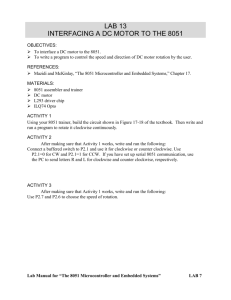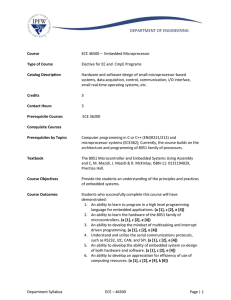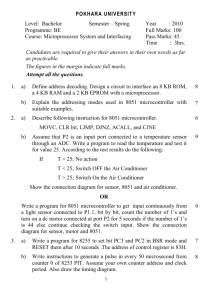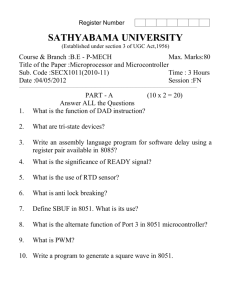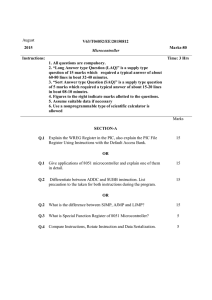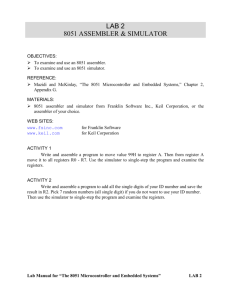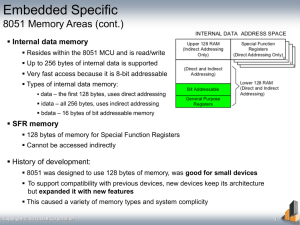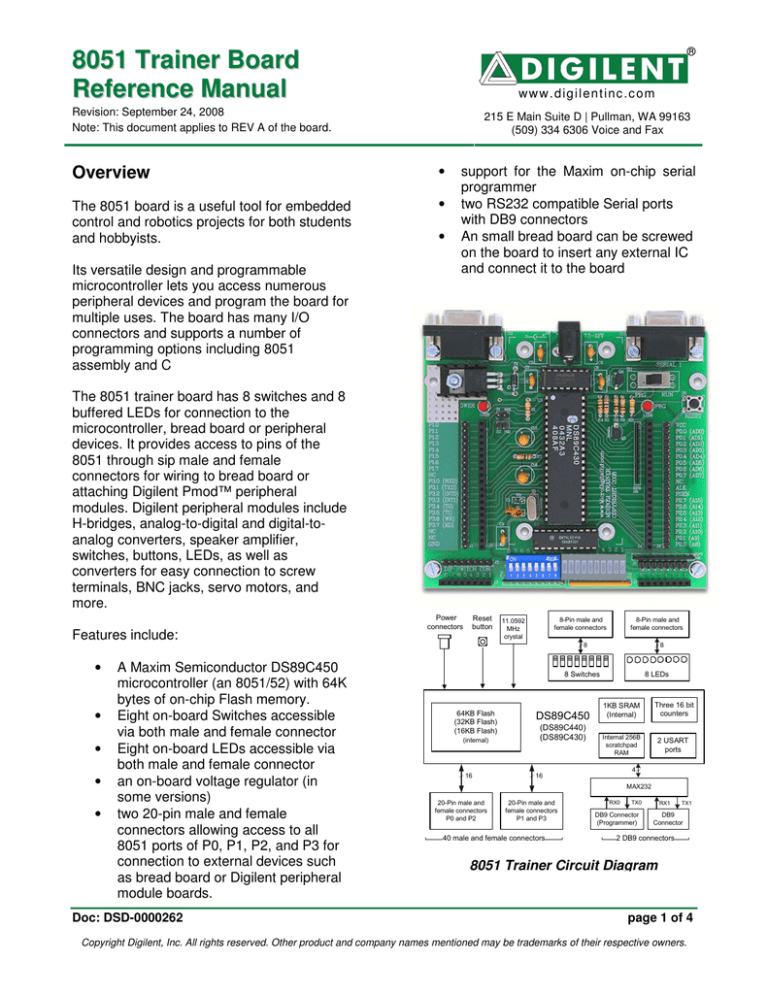
®
8051 Trainer Board
Reference Manual
ww w. d ig i l en t inc .c om
Revision: September 24, 2008
Note: This document applies to REV A of the board.
215 E Main Suite D | Pullman, WA 99163
(509) 334 6306 Voice and Fax
Overview
•
The 8051 board is a useful tool for embedded
control and robotics projects for both students
and hobbyists.
•
Its versatile design and programmable
microcontroller lets you access numerous
peripheral devices and program the board for
multiple uses. The board has many I/O
connectors and supports a number of
programming options including 8051
assembly and C
•
support for the Maxim on-chip serial
programmer
two RS232 compatible Serial ports
with DB9 connectors
An small bread board can be screwed
on the board to insert any external IC
and connect it to the board
The 8051 trainer board has 8 switches and 8
buffered LEDs for connection to the
microcontroller, bread board or peripheral
devices. It provides access to pins of the
8051 through sip male and female
connectors for wiring to bread board or
attaching Digilent Pmod™ peripheral
modules. Digilent peripheral modules include
H-bridges, analog-to-digital and digital-toanalog converters, speaker amplifier,
switches, buttons, LEDs, as well as
converters for easy connection to screw
terminals, BNC jacks, servo motors, and
more.
Features include:
Power
connectors
Reset
button
8-Pin male and
female connectors
11.0592
MHz
crystal
8-Pin male and
female connectors
8
•
•
•
•
•
A Maxim Semiconductor DS89C450
microcontroller (an 8051/52) with 64K
bytes of on-chip Flash memory.
Eight on-board Switches accessible
via both male and female connector
Eight on-board LEDs accessible via
both male and female connector
an on-board voltage regulator (in
some versions)
two 20-pin male and female
connectors allowing access to all
8051 ports of P0, P1, P2, and P3 for
connection to external devices such
as bread board or Digilent peripheral
module boards.
Doc: DSD-0000262
8
8 Switches
64KB Flash
(32KB Flash)
(16KB Flash)
(internal)
16
DS89C450
(DS89C440)
(DS89C430)
8 LEDs
1KB SRAM
(Internal)
Three 16 bit
counters
Internal 256B
scratchpad
RAM
2 USART
ports
4
16
MAX232
20-Pin male and
female connectors
P0 and P2
20-Pin male and
female connectors
P1 and P3
40 male and female connectors
RX0
TX0
DB9 Connector
(Programmer)
RX1
TX1
DB9
Connector
2 DB9 connectors
8051 Trainer Circuit Diagram
page 1 of 4
Copyright Digilent, Inc. All rights reserved. Other product and company names mentioned may be trademarks of their respective owners.
8051 Reference Manual
Features of the DS89C450 include:
•
•
•
•
•
•
On-chip loader using a serial port
two USART serial interfaces (COM
ports)
three 16-bit timer counters
64KB program flash
256B scratchpad RAM
1KB on-chip RAM accessible with
MOVX instruction.
For more information on the DS89C450
microcontroller, refer to the data sheet
available at www.maxim-ic.com.
Functional Description
The 8051 is designed for embedded control
and robotic applications as well as
microprocessor experimentation.
The 8051 has an on-chip loader/programmer:
The loader / programmer is accessed via
Serial COM Port #0 DB9 Connector.
The 8051 Trainer features a flexible power
supply routing system with VCC and GND pin
available on 20 pin male and female
connector for powering the ICs on the bread
board as well as Digilent Pmod peripheral
modules connected to the board.
Digilent Pmod peripheral modules can be
connected to the connectors on the 8051
Trainer board via cables. Digilent has a
variety of Pmod interconnect cables
available.
Digilent, Inc.
need to note that the silk screen voltage
doesn’t apply***
There is a power supply connector on 8051
trainer for board/processor. The barrel
connector is useful for desktop development
and testing. It is the connector used by the
DC supply adapter available from Digilent.
Programming the 8051 Trainer
The 8051 Trainer programming can be
accomplished using Serial#0. Programming
via Serial#0 requires use of the
HyperTerminal program which comes with
the Microsoft Windows Operating System.
For more information on programming the
8051 trainer and access some sample codes,
refer to www.microdigitaled.com
RS232 compatible Serial
connectors (DB9)
The DS89C450 microcontroller provides 2
USART serial interfaces. The 8051 trainer
board comes with MAX232 to convert TTL
voltage level to RS232. So you can connect
the 8051 trainer board directly to a PC.
Jumper Settings for second serial port
Jumpers S1 and S2 are provided for
connection the second serial port. If no
jumper is connected to S1 and S2, then the
P1.2 and P1.3 are disconnected from
MAX232 and can be used as simple I/O pins.
Power supply
The 8051 Trainer board may be powered via
the dedicated power supply connector.
The 8051 Trainer board is designed for
operation at 5V. Using a voltage other than
5V can damage the 8051 trainer or the
connected devices. ***Note: the earlier rev of
the board indicated in the silk screen that the
operating voltage range was 7.5V-12V. If this
didn’t get changed in the current rev, we
www.digilentinc.com
Crystal Oscillator
The DS89C450 microcontroller supports
numerous clock source options for the main
processor operating clock. The 8051 Trainer
has an 11.0592 MHz oscillator crystal.
11.0592 MHz oscillator crystal makes you
enable to connect the 8051 trainer board to
PC by COM port and the serial transfer error
will be as low as zero.
page 2 of 4
Copyright Digilent, Inc. All rights reserved. Other product and company names mentioned may be trademarks of their respective owners.
8051 Reference Manual
Digilent, Inc.
User I/O Pins
The 8051 Trainer board has two rows of
male and female connector for user to access
all the ports of the 8051 microcontroller
(DS89C450) plus 8 LEDs and 8 switched
available via 8 pin male and female sip
connectors.
8051 Trainer Headers Connection
Note: All 8051 ports can be used as general purpose I/Os or for the following specific purposes.
Connector
J2 and J4
Description
External memory bus
These pins are accessible for I/O operation. Also
they can be connected to the multiplexed
Address/Data line of the DS89C450 for external
memory bus interface.
P0
(Pin 2-9)
J2 and J4
P2
(Pin 13-20)
J1 and J3
P1
(Pin 1-8)
J1 and J3
P1
(Pin 10-17)
www.digilentinc.com
External memory bus
These pins are accessible for I/O operation. They
can be connected to the higher order address pins
of the external memory bus interface.
PORT1 is used for I/O operation. If jumper S1 and
S2 are connected P1.2 and P1.3 should not be
externally used because P1.2 and P1.3 are
connected to Max232. To be able to connect P1.2
and P1.3 to an external device you must disconnect
the S1 and S2 jumpers.
Serial port communications and interrupts
Asynchronous serial port, UART0, as well as the
8051 external interrupt sources are part of this port
Connection to Serial#0 is used on this port for an
RS232 serial interface. This is used for
programming (downloading) the hex file to
DS89C450 chip. No device can be connected to
P3.0 and P3.1 during programming.
8051 Trainer 20 Pins Header to
DS89C450 Ports / Bit
Pin
Function
Port / Bit
1
VCC
2
AD0
P0.0
3
AD1
P0.1
4
AD2
P0.2
5
AD3
P0.3
6
AD4
P0.4
7
AD5
P0.5
8
AD6
P0.6
9
AD7
P0.7
10
11
ALE
12
PSEN
13
A8
P2.0
14
A9
P2.1
15
A10
P2.2
16
A11
P2.3
17
A12
P2.4
18
A13
P2.5
19
A14
P2.6
20
A15
P2.7
1
I/O
P1.0
2
I/O
P1.1
3
I/O
P1.2
4
I/O
P1.3
5
I/O
P1.4
6
I/O
P1,5
7
I/O
P1.6
8
I/O
P1.7
9
10
RxD0
P3.0
11
TxD0
P3.1
12
INT0I
P3.2
13
INT1
P3.3
14
T0
P3.4
15
T1
P3.5
16
WR
P3.6
17
RD
P3.7
18
19
20
GND
page 3 of 4
Copyright Digilent, Inc. All rights reserved. Other product and company names mentioned may be trademarks of their respective owners.
8051 Reference Manual
connector
J5 and J7
J6 and J8
Digilent, Inc.
Description
Dip Switch Connectors
These pins provide access to switches. It provides
logical zero or one (0 or 5v) for the chip or any
external devices.
LED Connectors
These pins provide access to the LEDs. Each LED
input is buffered via 74LS244 and there is no need
for external diver.
8051 Trainer 8 Pins Headers
Pin
Function
1
Switch 1 of dipswitch
2
Switch 2 of dipswitch
3
Switch 3 of dipswitch
4
Switch 4 of dipswitch
5
Switch 5 of dipswitch
6
Switch 6 of dipswitch
7
Switch 7 of dipswitch
8
Switch 8 of dipswitch
1
LED 1
2
LED 2
3
LED 3
4
LED 4
5
LED 5
6
LED 6
7
LED 7
8
LED 8
Jumpers
Jumper Function
Label
RXD of serial #1
This jumper is used to connect p1.2 to the max232 IC. If jumper S1 is connected P1.2 should
S1
not be externally used because P1.2 is connected to Max232 through S1. To be able to connect P1.2
to an external device you must disconnect the S1 jumper on the board.
TXD of serial #1
This jumper is used to connect p1.3 to the max232 IC. If jumper S2 is connected P1.3 should
S2
not be externally used because P1.3 is connected to Max232 through S2. To be able to connect P1.3
to an external device you must disconnect the S2 jumper on the board.
www.digilentinc.com
page 4 of 4
Copyright Digilent, Inc. All rights reserved. Other product and company names mentioned may be trademarks of their respective owners.

